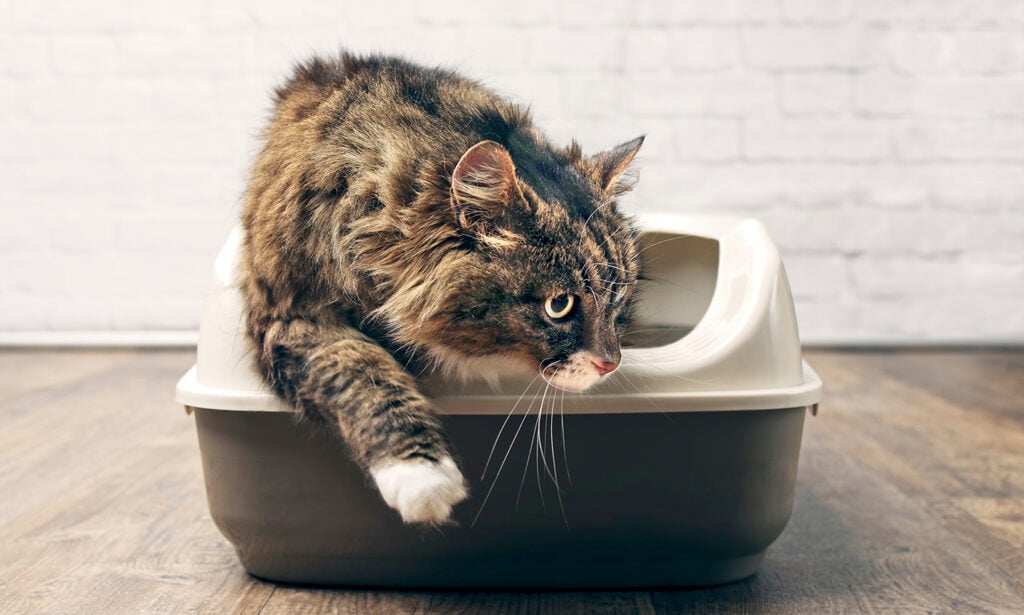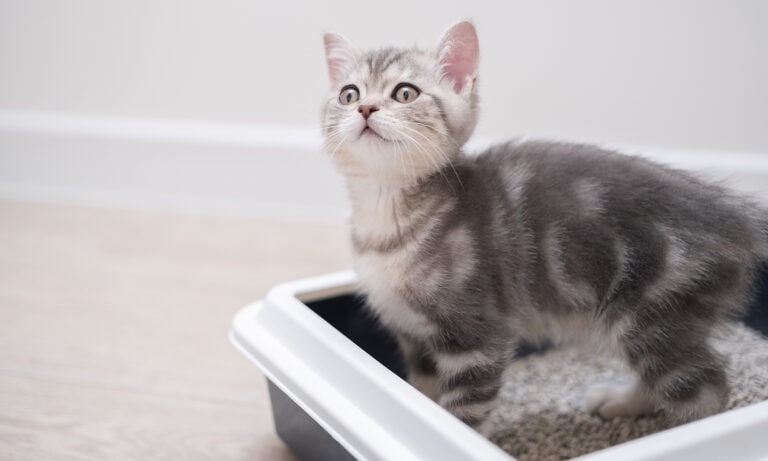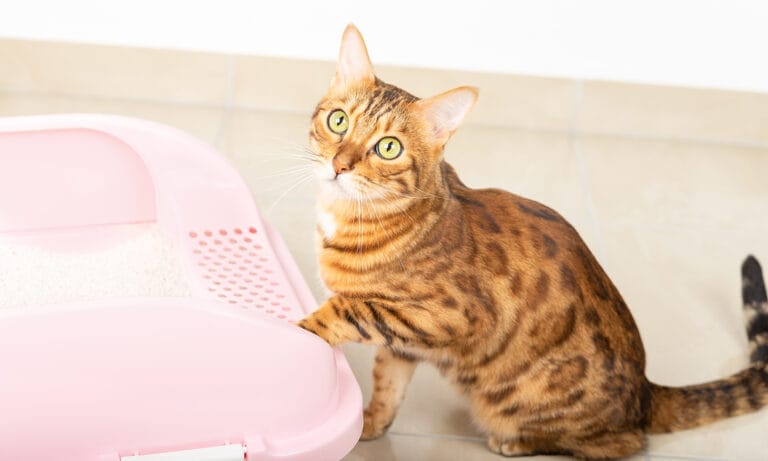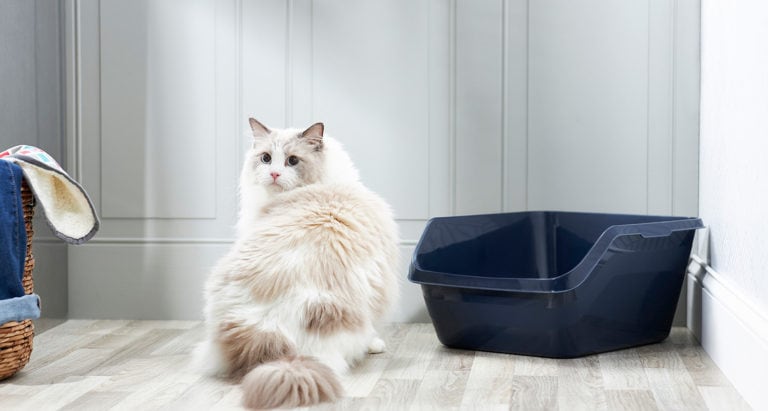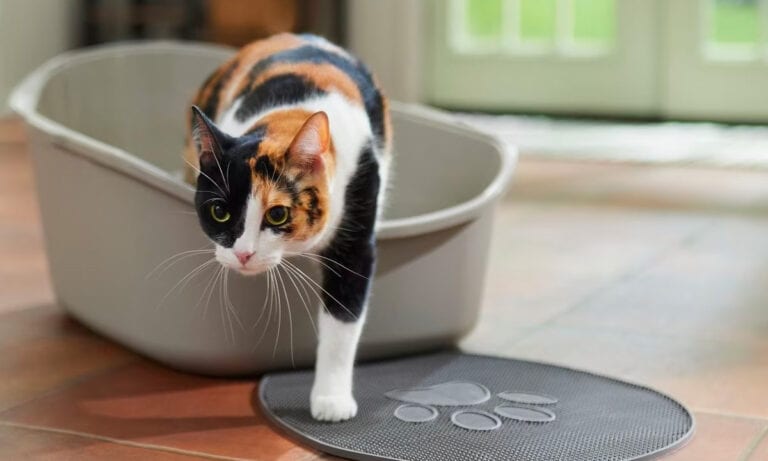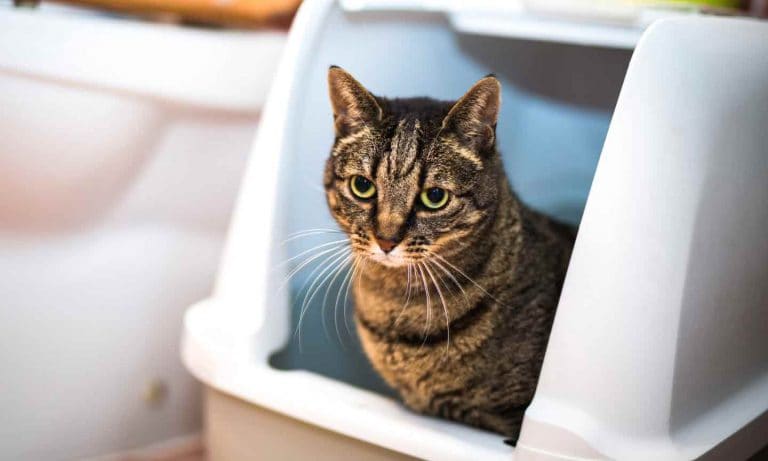Normally, a cat’s digestive system purrs right along, smoothly and without a hitch. But sometimes things can get a bit clogged, leading to constipation.
So, how do you get things moving again? A common approach is the use of cat laxatives, which help stimulate a bowel movement.
There are seven commonly used cat laxatives, but choosing the right one—with the guidance of your veterinarian—depends on a variety of factors, including the cause of constipation; your cat’s overall health and age; and any underlying medical conditions they have.
We spoke to vet experts to get the inside scoop on constipation and cat laxatives, including how they can help your furry pal and how to choose the right one.
Cat Laxatives
Click to jump to each section.
What Is Cat Constipation?
Cat constipation is a common health issue where a cat experiences difficulty passing feces or poops less frequently than normal, says Dr. Winnie Ybarra, DVM, DACVIM, a veterinary internist at San Francisco Animal Medical Center in San Francisco.
Cats typically poop once per day, although some poop twice daily. Pooping less than this could be a sign of constipation.
According to Dr. Nicole Savageau, VMD, a veterinarian with The Vets in Austin, Texas, common causes of constipation in cats include:
- Dehydration
- Lack of exercise
- Stress and anxiety
- Hairballs
- Dietary issues and food changes
- Inflammatory bowel disease
More serious causes can include pelvic injuries; a blockage due to a foreign body; kidney disease; megacolon (a condition where the colon becomes enlarged); neurological issues; and some types of cancer. In some cases, no underlying cause of constipation can be determined.
Symptoms of Cat Constipation
Unlike humans, cats can’t verbally communicate their discomfort, so it’s important for cat parents to be observant of their feline’s behavior and bodily functions. Recognizing the symptoms of constipation in cats is crucial for timely and effective treatment.
Below, Dr. Ybarra shares some common symptoms of constipation to watch for.
- Infrequent or no bowel movements
- Hard, round, dry feces (as opposed to well-formed, slightly soft feces)
- Straining in the litter box; spending a long time in the litter box; or avoiding the litter box altogether
- Displaying signs of pain or discomfort (like crying out) while trying to defecate
- Bloody or mucus-covered stools
- Blood or mucus around the rectum
- Lethargy or reduced activity
- Poor appetite
- Vomiting
- Abdominal bloating
How to Help a Constipated Cat: Cat Laxatives
When your cat is suffering from constipation, there are several steps you can take to help alleviate their discomfort and address the underlying issue. We’ll touch on the full gamut shortly, but first, let’s zero in on laxatives.
Cat laxatives are substances designed to help cats with constipation by facilitating bowel movements. They work in various ways, such as stimulating intestinal muscles or drawing water into the colon.
4 Types of Cat Laxatives
The choice of laxative depends on the severity of the constipation and the cat’s overall health. There are four main types of laxatives:
- Lubricant laxatives: Coats the stool and intestines in a lubricating film, easing the passage of feces.
- Osmotic laxatives: Draws water into the colon from surrounding tissues. This increased water content helps soften the stool and increases its volume, which, in turn, stimulates bowel movements.
- Stimulant laxatives: Triggers the intestines to contract and push out the stool.
- Bulk-forming laxatives: Provides fiber, which increases the bulk of the stool. This can stimulate a cat’s bowels.
7 Common Cat Laxatives
According to Dr. Ybarra and Dr. Savageau, common cat laxatives include:
- Cat Lax (lubricant)
- Mineral oil (lubricant)
- Polyethylene glycol 3350, aka Miralax (osmotic)
- Lactulose (osmotic)
- Cisapride (stimulant)
- Metoclopramide (stimulant)
- Psyllium husk, aka Metamucil (bulk-forming)
While not technically a laxative, canned, unsweetened pumpkin can also sometimes help relieve constipation. Pumpkins have a high water and fiber content, and can hydrate the intestines and their contents. A couple of pet parent pumpkin favorites are Weruva Pureed Pumpkin and Nummy Tum-Tum Pumpkin. Note that these pumpkin foods should not replace your cat’s regular food but rather act as a supplement to relieve occasional constipation.
Which Cat Laxative Should You Use?
The right laxative for your cat depends on a variety of factors, including the cause of constipation; your cat’s overall health and age; and any underlying medical conditions, says Dr. Ybarra.
It’s crucial to only give your cat a laxative based on a veterinarian’s recommendation and with their guidance. This not only ensures the treatment’s efficacy but also your feline friend’s safety and well-being. The improper or unsupervised use of laxatives can lead to complications such as dehydration, electrolyte imbalances or worsened constipation.
In addition to selecting a suitable laxative, your vet may also discuss other aspects of care that can help manage or prevent constipation.
Cat Laxative vs. Stool Softener
When addressing constipation in cats, it’s important to understand the difference between a cat laxative and a stool softener for cats, as they serve different purposes in managing the condition.
Cat Laxatives
Laxatives are generally used when there’s a need to actively induce a bowel movement.
They produce bowel movements in one of three ways:
- Stimulating the muscles of the intestines
- Drawing water into the bowel from surrounding tissues
- Increasing the weight or “bulk” of the stool
Stool Softeners
Stool softeners, on the other hand, work by increasing the amount of water absorbed by the stool in the intestines, Dr. Savageau says. This process results in softer stool, which is easier for the cat to pass.
Stool softeners are particularly beneficial for cats who need to avoid straining during defecation, such as those with certain medical conditions or post-surgical cases.
In some cases, both laxatives and stool softeners are used.
When to Go to the Vet
If not properly treated, constipation in cats can lead to several health risks, some of which can be life-threatening, such as:
- Megacolon: A condition where the colon becomes abnormally enlarged and loses its ability to function properly. This can be caused by the colon being consistently stretched more than it should be, such as when a cat has chronic constipation.
- Obstipation: A severe form of constipation where a cat cannot pass any stool or gas, usually due to fecal matter becoming dry and hard in the intestines.
- Toxemia: A condition that can occur when prolonged constipation leads to the accumulation and stagnation of feces in the colon. This stagnation can result in the absorption of toxins into the bloodstream.
Due to these risks, it’s essential to treat constipation promptly. If constipation persists for more than 24–48 hours, bring your cat to a veterinarian. The doctor can assess your cat’s health; work to determine the underlying cause; and provide a treatment plan.
Cat Constipation Treatment
Dr. Savageau shares some common cat constipation remedies, including:
- Increase water intake: Dehydration is a common cause of constipation. Ensure your cat has access to fresh, clean water at all times. Consider using a cat water fountain, such as the Drinkwell Pet Fountain or Catit Flower Fountain, as cats often prefer running water. Learn more tips to get your kitty to drink more water.
- Dietary changes: Your vet might recommend incorporating more fiber and water into your cat’s diet through wet food, specially formulated cat food or nutritional supplements, such as psyllium husk or canned pumpkin. A higher fiber diet should be introduced gradually to avoid upsetting your cat’s stomach.
- Laxatives or stool softeners: Your vet might give your cat specific laxatives or stool softeners to get things moving or soften the stool.
- Exercise: Encourage your cat to engage in regular physical activity. Play sessions can help stimulate digestion and bowel movements.
- Reducing stress: In some cases, stress and anxiety can cause constipation. Stress can be caused by big things like adding a new pet to the house, or smaller things like construction noise outside. Soothing your cat, and reducing or removing environmental stress, if possible, could help ease constipation. Explore popular cat calming aids.
Ultimately, the treatment for constipation depends on its severity, adds Dr. Ybarra. “If the constipation is mild, adding water, canned food or fiber to the diet can help,” she says. If it’s more severe, enemas (performed by a vet) and medication might be needed. “Very severe cases require manual deobstipation under anesthesia,” she says.
FAQs About Cat Constipation
Q:
Is cat constipation an emergency?
Q:
What is the fastest way to relieve cat constipation?
Q:
Can you manually help a cat poop?
Q:
What causes a cat to be constipated?
Q:
What is the best cat laxative?
Q:
Can probiotics help with cat constipation?
Q:
How can you soften cat stool?
By recognizing the symptoms of constipation, knowing when to seek veterinary assistance and understanding the treatment options available, you can ensure your cat remains comfortable and healthy.
Looking for more information surrounding kitty bathroom conundrums? Find out how to handle kitten constipation and why your cat might have stopped using their litter box.
More about cat constipation:
Share:
